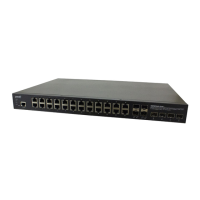Lantronix SISPM1040-xxxx-L3 Web User Guide
33856 Rev. A https://www.lantronix.com/ 19
System > IP Address > Settings
This page lets you set basic IP settings, IP interfaces, and IP routes. The IPv4 address for the switch can be
obtained via DHCP Server for VLAN 1. To manually configure an address, you must change the switch default
settings to values that are compatible with your network. You may also need to establish a default gateway
between the switch and management stations that exist on another network segment.
IPv4 DHCP Client Enable: Enable the DHCPv4 client by sliding this from off to on. If this option is enabled,
the system will configure the IPv4 address and subnet mask of the interface using the DHCPv4 protocol.
The DHCPv4 client will announce the configured System Name as hostname to provide DNS lookup.
IPv4 Address: The IPv4 address of the interface in dotted decimal notation. If DHCP is enabled, this field
configures the fallback address. The field may be left blank if IPv4 operation on the interface is not desired or if no
DHCP fallback address is desired.
Subnet Mask: The IPv4 network mask, in number of bits (prefix length). Valid values are 0-30 bits for an IPv4
address. If DHCP is enabled, this field configures the fallback address network mask. The field may be left blank if
IPv4 operation on the interface is not desired or if no DHCP fallback address is desired.
Gateway: The IP address of the IP gateway. Valid format is dotted decimal notation or a valid IPv6 notation.
Gateway and Network must be of the same type.
DNS Server: This setting controls the DNS name resolution done by the switch. There are four servers available
for configuration, and the index of the server presents the preference (less index has higher priority) in doing DNS
name resolution. These modes are supported:
No DNS server: No DNS server will be used.
Configured IPv4: Explicitly provide the valid IPv4 unicast address of the DNS Server in dotted decimal
notation. Make sure the configured DNS server is reachable (e.g., via PING) for activating DNS service.
Configured IPv6: Explicitly provide the valid IPv6 unicast (except linklocal) address of the DNS Server.
Make sure the configured DNS server could be reachable (e.g., via PING6) for activating DNS service.
From any DHCPv4 interfaces: The first DNS server offered from a DHCPv4 lease to a DHCPv4-enabled
interface will be used.
From this DHCPv4 interface: Specify from which DHCPv4-enabled interface a provided DNS server
should be preferred.
From any DHCPv6 interfaces: The first DNS server offered from a DHCPv6 lease to a DHCPv6-enabled
interface will be used.
From this DHCPv6 interface: Specify from which DHCPv6-enabled interface a provided DNS server
should be preferred.

